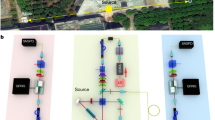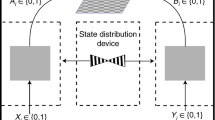Abstract
We propose a device to secure random data in analog format, so that it is taken off the digital grid. Such action will turn off the means by which remote hackers violate security. A physical “rock” manufactured through 3D printing technology, constructed on the basis of high-grade randomness, which is packed into the comprising materials of that rock. The rock functions as an oracle, and does not allow any massive copy of its content. Thus, a major claim of this Prospective is that materials science and engineering may hold the keys to the future of cryptography.



Similar content being viewed by others
References
N. Smart: Cryptography: An Introduction, 3rd ed. (McGraw-Hill, New York, 2013), http://www.cs.umd.edu/~waa/414-F11/lntroToCrypto.pdf.
C. Stocker and G. Samid: What a 100 years old idea can teach us about cyber security, The World Economic Forum, Davos, Switzerland (2017), https://www.weforum.org/agenda/2017/11/what-a-100-year-old-idea-can-teach-us-about-cybersecurity.
C. Shannon: Communication theory of secrecy systems, Bell Syst. Tech. J. 28, 656 (1949), http://netlab.cs.ucla.edu/wiki/files/shannon1949.pdf.
M. Camesasca, M. Kaufman and I. Manas-Zloczower: Quantifying fluid mixing with the Shannon entropy. Macromol. Theory Simul. 15, 595–607 (2006).
M. Camesasca, K. Alemaskin, I. Manas-Zloczower and M. Kaufman: Entropic measures of mixing tailored for various applications, The 2004 NSF Design, Service and Manufacturing Grantees Research Conference Proceedings.
G. Samid: US patent application US2008/0144432 A1 (2008).
K. Miyasaka, K. Watanabe, E. Jojima, H. Aida, M. Sumita and K. Ishikawa: Electrical conductivity of carbon-polymer composites as a function of carbon content. J. Mater. Sci. 17, 1610 (1982).
J.-C. Huang: Carbon black filled conducting polymers and polymer blends. Adv. Polym. Technol. 21, 299–313 (2002).
R.D. Sudduth: A percolation threshold model that effectively characterizes the full concentration range for electrical-conducting polymer composites. J. Appl. Polym. Sci. 136, 47184 (2019).
G.E. Wnek: Electrically conductive polymers. MRS Bull. 12(8), 36 (1987).
A.G. MacDiarmid and A.J. Epstein: Conducting polymers: past, present and future. Mat. Res. Soc. Symp. Proc. 328, 133–144 (1994).
D.W. Hatchett and M. Josowicz: Composites of intrinsically conducting polymers as sensing nanomaterials. Chem. Rev. 108, 746–769 (2008).
I. Gibson, D. Rosen and B. Stucker: Additive Manufacturing Technologies: 3-D Printing, Rapid Prototyping, and Direct Digital Manufacturing, 2nd ed. (Springer, New York, 2015).
M. Shusteff, A.E.M. Browar, B.E. Kelly, J. Henriksson, T.H. Weisgraber, R.M. Panas, N.X. Fang and C.M. Spadaccini: One-step volumetric additive manufacturing of complex polymer structures, Sci. Adv. 3 120, eaao5496 (2017).
J.R. Tumbleston, D. Shirvanyants, N. Ermoshkin, R. Janusziewicz, A.R. Johnson, D. Kelly, K. Chen, R. Pinschmidt, J.P. Rolland, A. Ermoshkin, E.T. Samulski and J.M. DeSimone: Continuous liquid interface production of 3D objects. Science 347, 1349–1352 (2015).
S.S. Babu, L. Love, R. Dehoff, W. Peter, T.R. Watkins and S. Pannala: Additive manufacturing of materials: opportunities and challenges. MRS Bull. 40, 1154–1161 (2015).
G. Samid: User-centric cryptography—shifting power from the cipher designer to the cipher user, 2018 International Conference on Security and Management, August 2018, Las Vegas, NV.
G. Samid: Randomness rising, 14th International Conference on Foundations of Computer Science (FCS’18: July 30-August 2018, Las Vegas, NV.
G. Samid: Randomness as absence of symmetry, The 17th International Conference on Information & Knowledge Engineering (lke’18) Las Vegas, NV.
G.S. Vernam: US Patent 1310719 (1918).
Author information
Authors and Affiliations
Corresponding author
Additional information
G. Samid is also an adjunct professor in the Department of Electrical Engineering and Computer Science, Case Western Reserve University. Correspondence: gideon@bitmint.com or gideon.samid@case.edu
Rights and permissions
About this article
Cite this article
Samid, G., Wnek, G.E. The “Rock of Randomness”: a physical oracle for securing data off the digital grid. MRS Communications 9, 67–76 (2019). https://doi.org/10.1557/mrc.2019.8
Received:
Accepted:
Published:
Issue Date:
DOI: https://doi.org/10.1557/mrc.2019.8




